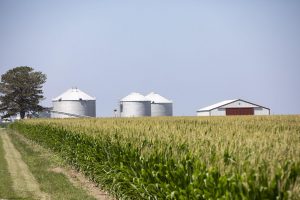Millennials getting priced out of farmland market
By Daniel Grant FarmWeek — August 9, 2022
Young farmers can help farms advance in the future with the introduction of technology and by staying in touch with consumer needs, notes Pat Spinosa, director of business development at AgAmerica.
A significant increase in farmland prices and low turnover rate are making it more difficult for many farmers to expand their operations.
And perhaps the demographic of farmers getting squeezed the most in the current economic environment are millennials, those between the ages of 26 and 41, according to AgAmerica, the nation’s largest non-bank agricultural lender.
It recently reported more than 40 percent of U.S. farmland is owned by people older than 65. And now younger generations, who often have fewer resources compared to veteran farmers, are facing another real estate barrier to enter the ag industry as farmland prices surge.
“It’s so tough to maintain an operation when it comes to rising operating and input costs,” Pat Spinosa, director of business development at AgAmerica, told FarmWeek. “Then, when you look at expansion, it’s nearly impossible for some people when you look at these prices.”
The Federal Reserve Bank of Chicago reported farmland values in its district increased 23 percent during the first quarter of 2022 compared to last year.
This follows increases of Illinois farmland values between 2020 and 2021 of 26 percent for excellent ground to an average of $14,700 per acre, 24 percent for good ground ($10,710 per acre) and 21 percent for average land ($7,455 per acre), according to the Illinois Society of Professional Farm Managers and Rural Appraisers.
Last year marked just the fourth time since 1970 Illinois farmland values increased 20 percent or more in a calendar year.
“We have to get the younger generation into farming but, with these farmland prices, many can’t afford to buy a $15,000 or $20,000 piece of dirt and then have to deal with the high input costs on top of that,” Spinosa said.

More than 40 percent of U.S. farmland is owned by people older than 65. And now younger generations, who often have fewer resources compared to veteran farmers, are facing another real estate barrier to enter the ag industry as farmland prices surge. (Photo by Illinois Farm Bureau photographer Catrina Rawson)
A low turnover rate of farmland, about 2 percent per year, and intense competition also continues to drive the market and put the squeeze on some potential buyers.
Farmers remained the top buyer of farmland in the state last year, but just barely, at 52 percent. Investors reeled in 33 percent of farmland purchases and institutions grabbed another 10 percent, with the remaining 5 percent made up of individuals who purchased land for recreational purposes, according to ISPFMRA.
“We do see a bit of inflation hedge with farmland,” said David Oppedahl, senior business economist at the Chicago Fed. “Farmers and investors are interested in locking in value there through purchasing farmland.
“In the current inflationary environment, ag’s been helped by some factors (commodity prices received by farmers increased 31 percent compared to last year, prior to a recent sell off in the market),” he noted. “At the same time, input costs are going up a lot, so that squeezes margins.”
AgAmerica encourages farmers, particularly those among the younger generations, to build relationships with lenders and fellow farmers. Young farmers can also help farms advance in the future with the introduction of technology and by staying in touch with consumer needs, Spinosa noted.
“We’ve got a generational gap between who’s farming now and we’ve got millennials coming into farming,” he said.
“When you think about inflation, interest rates and rising operating costs, now is the time to build relationships with lenders and have partnerships with someone who fits in your operation and helps you get through these tough times.”
Building relationships is also vital for farmers in the highly competitive market for rental ground. Of the farmers enrolled in Illinois Farm Business Farm Management, just 23 percent owned their land, 30 percent was a crop share and 47 percent was a cash rental arrangement in 2021.
This story was distributed through a cooperative project between Illinois Farm Bureau and the Illinois Press Association. For more food and farming news, visit FarmWeekNow.com.



